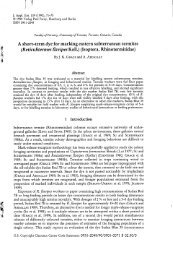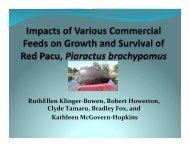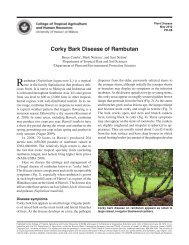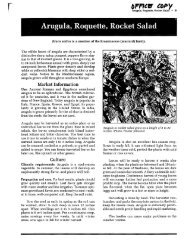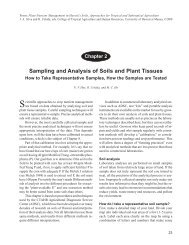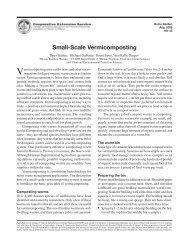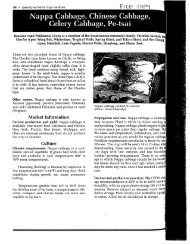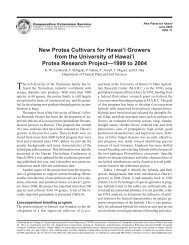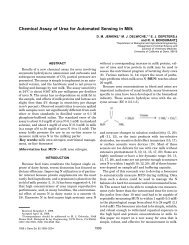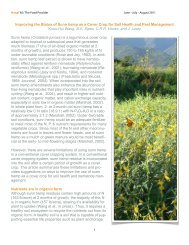Macadamia Nuts in Hawaii: History and Production - ctahr ...
Macadamia Nuts in Hawaii: History and Production - ctahr ...
Macadamia Nuts in Hawaii: History and Production - ctahr ...
Create successful ePaper yourself
Turn your PDF publications into a flip-book with our unique Google optimized e-Paper software.
orig<strong>in</strong>al 70 trees are still <strong>in</strong> production. In view of<br />
this demonstration, Castle & Cooke planted an<br />
additional 1000 acres (405 hectares) <strong>in</strong> squares 30<br />
feet (9.2 meters) by 30 feet (9.2 meters), with an<br />
additional tree planted <strong>in</strong> the center of the square<br />
for a total of 96 trees per acre. The additional trees<br />
are to be elim<strong>in</strong>ated <strong>in</strong> 20 years or so, to result <strong>in</strong> a<br />
square orchard with 50 trees, 30 feet apart, per acre.<br />
The orig<strong>in</strong>al trees at C. Brewer <strong>in</strong> Ka'u were<br />
planted <strong>in</strong> the 1960s <strong>in</strong> a 25-foot-square pattern to<br />
give 70 trees per acre. Beg<strong>in</strong>n<strong>in</strong>g <strong>in</strong> the late 1970s<br />
plant<strong>in</strong>g has been <strong>in</strong> rows spaced at 25 feet <strong>and</strong><br />
trees <strong>in</strong> the row spaced at 18 feet, giv<strong>in</strong>g each<br />
plant<strong>in</strong>g area a square footage of 450, or 97 trees<br />
per acre. When the closely planted trees are alternately<br />
elim<strong>in</strong>ated as they close <strong>in</strong> <strong>and</strong> beg<strong>in</strong> to<br />
shade each other, the ultima te diagonal distance<br />
between trees will be an adequate 30.8 feet, which<br />
should be the permanent distance between trees <strong>in</strong><br />
a mature orchard at 48.4 trees per acre.<br />
Dense plant<strong>in</strong>g to advance development of an<br />
early cash flow, <strong>and</strong> subsequent alternate-tree<br />
elim<strong>in</strong>a tion as the orchard trees beg<strong>in</strong> to close <strong>in</strong>,<br />
is economically very sound; it should be practiced<br />
universally. In an orchard operated under a corporate<br />
structure, where the operations are done on<br />
a relatively large scale <strong>and</strong> very impersonally, the<br />
design of plant<strong>in</strong>g <strong>and</strong> subsequent tree elim<strong>in</strong>ation<br />
are agreed upon prior to plant<strong>in</strong>g. Consequently,<br />
tree elim<strong>in</strong>ation can be done without any<br />
second thought when the orchard closes <strong>in</strong>. However,<br />
on a smaller farm where the owner also operates<br />
the farm, tree elim<strong>in</strong>ation can become a difficult<br />
issue s<strong>in</strong>ce it can temporarily reduce yield<br />
when done drastically. This becomes a problem<br />
44<br />
especially when the tree to be elim<strong>in</strong>ated happens<br />
to be heal thier <strong>and</strong> better than the permanent trees<br />
next to it.<br />
Anticipat<strong>in</strong>g a difficult decision at a later date,<br />
the permanent orchard can be completely laid out<br />
<strong>in</strong>itially <strong>in</strong> an equilateral (qu<strong>in</strong>cunx) design to<br />
make the best use of the spaces between trees. This<br />
decision is a compromise at the start, which enables<br />
the orchardist to know exactly where he is at<br />
the beg<strong>in</strong>n<strong>in</strong>g. Figure 57 graphically illustrates<br />
the loss <strong>in</strong> l<strong>and</strong> area utilization when the trees are<br />
planted <strong>in</strong> a square rather than <strong>in</strong> an equilateral<br />
triangle. A reasonable assumption is that a tree<br />
with branches emerg<strong>in</strong>g <strong>in</strong> all directions will grow<br />
<strong>in</strong> a more or less circular, ra ther than triangular or<br />
square, pattern. If this assumption is correct, the<br />
large "dead" area among four trees <strong>in</strong> a square can<br />
be expensively underutilized. This "dead" area<br />
can be much reduced by us<strong>in</strong>g the equilateral<br />
plant<strong>in</strong>g scheme. For example, <strong>in</strong> a 30-foot-square<br />
pattern, each tree is allocated 900 square feet of<br />
l<strong>and</strong> area. On the other h<strong>and</strong>, with the same distance<br />
between trees, 30 feet, <strong>in</strong> an equilateral<br />
triangular pattern, the distance between the rows<br />
of trees will be 26 feet. Trees <strong>in</strong> this pattern will<br />
then be allocated 780 square feet. Express<strong>in</strong>g this<br />
ga<strong>in</strong> <strong>in</strong> number of trees, a 30-foot by 30-foot square<br />
will allow only 48 trees per acre, while the 30-foot<br />
equilateral triangular pattern will allow 56 trees<br />
per acre, an <strong>in</strong>crease of eight trees, or 17 percent.<br />
Perhaps this is a better way to <strong>in</strong>crease early <strong>and</strong><br />
cont<strong>in</strong>ued production.<br />
Another essential factor <strong>in</strong> tree spac<strong>in</strong>g is the<br />
growth habits of the trees. Some of the selected<br />
clones are more dome shaped, <strong>and</strong> some more<br />
Figure 57. Graphic representation of plant<strong>in</strong>g design to illustrate space loss <strong>in</strong> a<br />
square plant<strong>in</strong>g compared to the equilateral triangular (qu<strong>in</strong>cunx) system.



